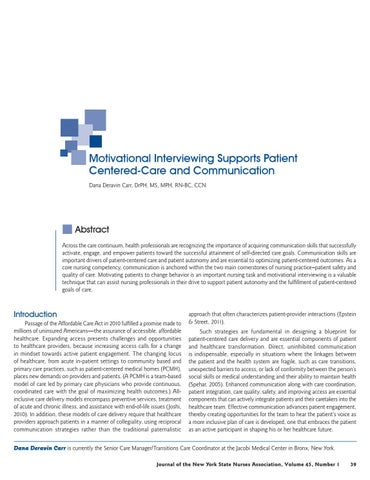Motivational Interviewing Supports Patient Centered-Care and Communication Dana Deravin Carr, DrPH, MS, MPH, RN-BC, CCN
■ Abstract Across the care continuum, health professionals are recognizing the importance of acquiring communication skills that successfully activate, engage, and empower patients toward the successful attainment of self-directed care goals. Communication skills are important drivers of patient-centered care and patient autonomy and are essential to optimizing patient-centered outcomes. As a core nursing competency, communication is anchored within the two main cornerstones of nursing practice–patient safety and quality of care. Motivating patients to change behavior is an important nursing task and motivational interviewing is a valuable technique that can assist nursing professionals in their drive to support patient autonomy and the fulfillment of patient-centered goals of care.
Introduction Passage of the Affordable Care Act in 2010 fulfilled a promise made to millions of uninsured Americans—the assurance of accessible, affordable healthcare. Expanding access presents challenges and opportunities to healthcare providers, because increasing access calls for a change in mindset towards active patient engagement. The changing locus of healthcare, from acute in-patient settings to community based and primary care practices, such as patient-centered medical homes (PCMH), places new demands on providers and patients. (A PCMH is a team-based model of care led by primary care physicians who provide continuous, coordinated care with the goal of maximizing health outcomes.) Allinclusive care delivery models encompass preventive services, treatment of acute and chronic illness, and assistance with end-of-life issues (Joshi, 2010). In addition, these models of care delivery require that healthcare providers approach patients in a manner of collegiality, using reciprocal communication strategies rather than the traditional paternalistic
approach that often characterizes patient-provider interactions (Epstein & Street, 2011). Such strategies are fundamental in designing a blueprint for patient-centered care delivery and are essential components of patient and healthcare transformation. Direct, uninhibited communication is indispensable, especially in situations where the linkages between the patient and the health system are fragile, such as care transitions, unexpected barriers to access, or lack of conformity between the person’s social skills or medical understanding and their ability to maintain health (Spehar, 2005). Enhanced communication along with care coordination, patient integration, care quality, safety, and improving access are essential components that can actively integrate patients and their caretakers into the healthcare team. Effective communication advances patient engagement, thereby creating opportunities for the team to hear the patient’s voice as a more inclusive plan of care is developed, one that embraces the patient as an active participant in shaping his or her healthcare future.
Dana Deravin Carr is currently the Senior Care Manager/Transitions Care Coordinator at the Jacobi Medical Center in Bronx, New York. Journal of the New York State Nurses Association, Volume 45, Number 1
39



